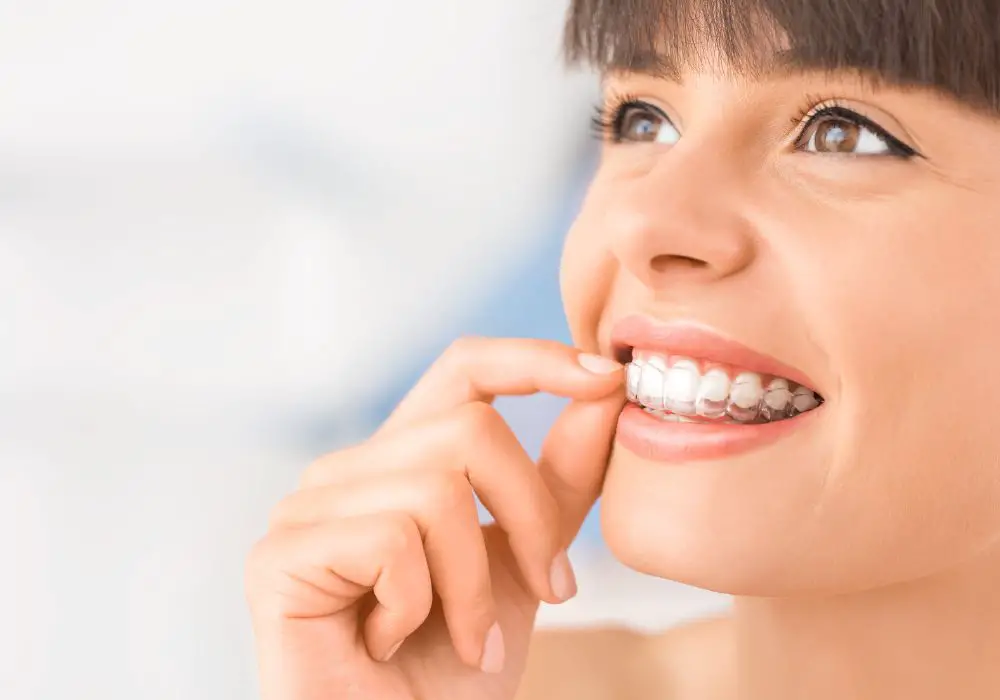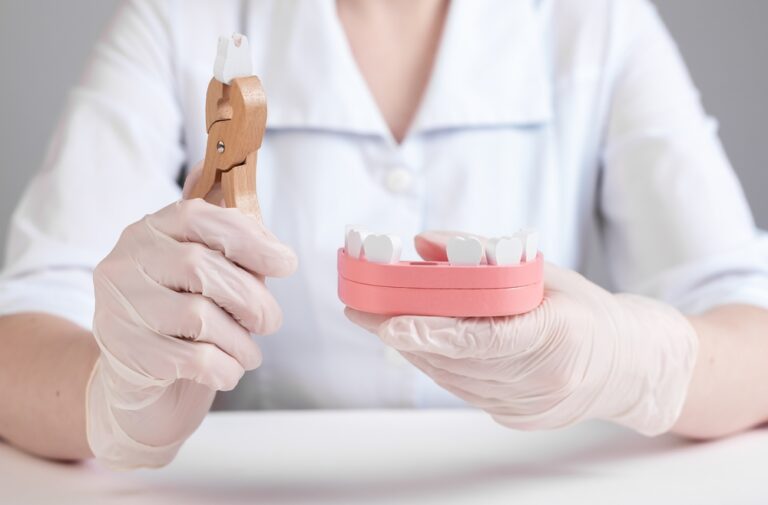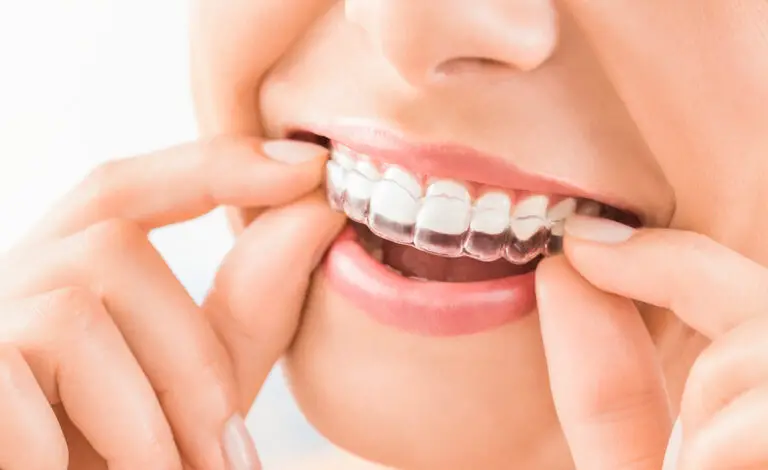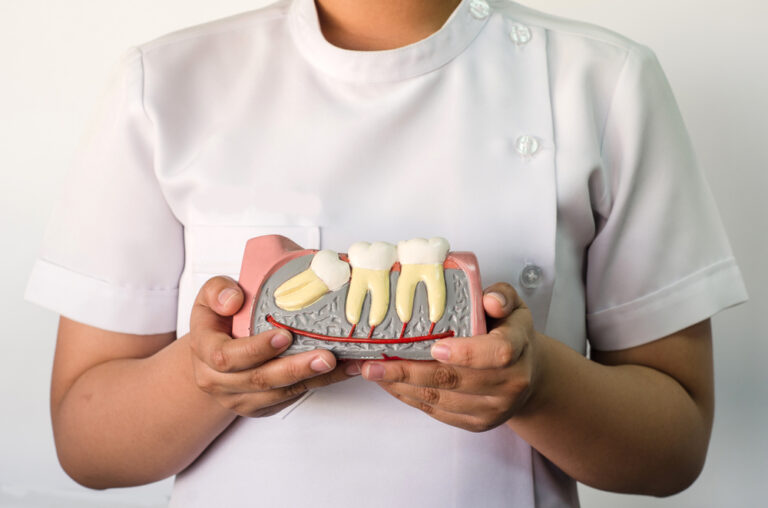Invisalign has revolutionized orthodontic treatment with its innovative use of removable clear aligner trays to straighten teeth. But if you already have “fake” teeth like dental implants, crowns, bridges or dentures, you may be wondering if Invisalign is still an option for you.
The good news is – most of the time Invisalign can successfully work alongside veneers, dental implants and certain crowns or bridges to align your remaining natural teeth and enhance your smile. However, it requires thorough coordination between your orthodontist and restorative dentist.
In this detailed guide, we will cover:
- How Invisalign works
- Important considerations with various types of artificial teeth
- Dental provider roles and treatment planning
- What to expect with Invisalign and prosthetic teeth
- Cost and treatment time factors
- Success rates and results
By understanding the process, planning required, limitations and options for treatment with prosthetic teeth, you can make an informed decision about using Invisalign to improve your special smile.
Overview of Invisalign Treatment

Before looking at specific considerations for restored smiles, let’s first understand the basics of Invisalign treatment.
Invisalign uses a series of clear plastic trays called aligners that are custom-fit to your teeth and changed out every 1-2 weeks during treatment. Each aligner applies carefully calibrated force to incrementally move your teeth into the position determined by your orthodontist.
The key steps for Invisalign treatment involve:
Impressions and 3D Modeling
The first step is to take impressions or an oral scan of your teeth. This creates a highly detailed 3D digital model of your smile. Your orthodontist then uses special software to map out the exact sequence of tooth movements needed to achieve your goals.
Custom Aligner Production
The planned digital movements are sent to Align Technology’s production facilities. Using stereolithography technology, each of your custom aligners is precision 3D printed from the model.
Wearing Aligners Full-Time
You’ll receive 20-30 sets of aligners to wear over the course of treatment. Each set should be worn 20-22 hours per day, only removing them to eat, drink, brush and floss. Every 2 weeks, you’ll switch to the next set of aligners in the series to keep teeth moving forward gradually.
Appointments and Refinements
You’ll have regular check-ins with your orthodontist throughout treatment to monitor progress and ensure the aligners are fitting and tracking properly. Refinement aligners are often needed at the end of treatment to fine-tune the results.
The total Invisalign treatment time averages 9-15 months but can vary based on your specific case. When worn according to instructions, aligners apply ideal calibrated force to straighten teeth comfortably and efficiently.
Now let’s look closer at how Invisalign can work with different types of artificial dental restorations like implants, bridges, crowns and veneers.
Invisalign With Dental Implants
Dental implants are one of the most common and effective ways to replace missing teeth. An implant consists of a small titanium post surgically embedded into the jaw bone, topped with an artificial crown or attachment. The bone integrates tightly with the implant post so it acts and feels like a natural tooth root.
The crown – the part that looks like a real tooth – attaches onto the implant post to complete the tooth restoration. Implant crowns can be single units or connected together in a bridge. With proper care, implants can last a lifetime.
So how does Invisalign work if you have existing dental implants?
Advantages
Here are some of the advantages of using Invisalign with dental implants:
- Implants are stationary – Unlike natural tooth roots, dental implants fuse securely to the jaw bone and cannot shift or move. This provides firm anchorage for moving other teeth.
- Invisalign moves natural teeth – The aligners are only able to apply force to natural teeth. However, they can effectively move those natural teeth around properly placed implants.
- Attach aligners to implants – Small tooth-colored buttons or precision wings can be bonded to the surface of implant crowns. This allows the Invisalign aligner to grip onto the stationary implants for anchorage as other teeth are moved.
- Protect implants – Dental implants and restorations are expensive investments. Invisalign aligners must fit over and apply force around them without damaging the implant crowns. Careful treatment planning prevents excess stresses.
Considerations
However, there are some important considerations for using Invisalign with pre-existing dental implants:
- Condition of implants – Implants must be successfully integrated in the bone and the restorations in good condition prior to treatment. Healing and osseointegration after placement takes 3-6 months.
- Attachments on implants – Some implant crown surfaces may need to be roughened first so that attachments adhere properly and stay bonded for the duration of treatment.
- Amount of movement – How much straightening movement is planned around the implants? Extensive movement creates more force which needs to be dissipated carefully.
- Restorative work – Will implant crowns need to be remade, reshaped or restored differently during the process to accommodate aligners and attachments? If so, added dental work increases the cost.
- Implant position – The location and angle of implants will impact how difficult it is to move other teeth around them. Skewed implants make treatment more complex.
With coordination between your orthodontist and restorative dentist, Invisalign can safely and effectively work with well-integrated dental implants in most cases. But careful case selection and planning is vital.
Invisalign With Dental Crowns

After an injured or decayed tooth is shaved down and covered with a dental crown, that prosthetic crown cannot be moved with Invisalign aligners. However, Invisalign can still shift other natural teeth around the stationary crowns. Here’s how:
Advantages
Some benefits of using Invisalign with existing dental crowns include:
- Only natural teeth move – Invisalign aligners apply force to the natural teeth but don’t affect cemented crowns. The crowns act as anchors.
- Attach aligners to crowns – Small rounded button attachments or interproximal wings can be bonded onto crowns to help engage and move natural teeth into place.
- Reshape crowns if needed – Some crown contours may need adjustment for proper aligner fit. Your dentist can carefully recontour crowns when required.
- Protect crown integrity – No excess force should be applied directly onto crowns to minimize risks of debonding or damage.
Considerations
However, there are some key factors to consider with Invisalign treatment around existing crowns:
- Crown material – What material is it made from? PFM metal crowns are the most rigid. All-ceramic crowns are more brittle. Resin or ceramic fused to metal crowns can be too flexible. The material affects resilience.
- Crown age – Older crowns are more prone to complications like debonding of attachments or mechanical failure. Newer crowns can better withstand orthodontic forces.
- Amount of tooth repositioning – How much will the natural teeth need to be moved? Large movements add more force against the crowns which can increase risks.
- Temporary crowns – In some cases, temporary crowns may be required during treatment to allow attachment placement or recontouring before final crowns are placed.
With careful diagnosis and planning, most modern dental crowns (especially all-ceramic) can be leveraged safely as anchors for Invisalign treatment. But the condition and type of crowns must be evaluated.
Invisalign With Dental Veneers
Dental veneers are thin shells of porcelain or composite material that are bonded onto the front and sides of teeth. Most often used to improve the look of crooked, chipped, worn or stained teeth, veneers are minimally invasive.
Here are some tips for using Invisalign treatment on teeth with existing veneers:
Advantages
- Veneers don’t move – Like dental crowns, veneers cannot be repositioned once bonded onto teeth. But teeth can be moved around the stable veneers.
- Minimal impact – In most cases, veneers don’t interfere with Invisalign treatment since they mimic the shape and feel of natural teeth well. Aligners fit comfortably over them.
- Bond attachments to teeth – Any needed attachments are bonded onto natural enamel, not the porcelain veneers themselves. This protects veneer integrity.
- Reshape composites if needed – If composite veneers require adjustment for proper aligner fit, it’s non-invasive. Porcelain must be professionally recontoured.
Considerations
A few important considerations include:
- Placement – Are veneers placed only on front teeth or do they wrap onto biting surfaces? More veneer coverage makes Invisalign movements more difficult.
- Veneer thickness – Thicker veneers (0.7mm+) are too bulky and could inhibit proper aligner fit and traction.
- Teeth affected – Are veneers bonded to all teeth or just a few? More veneers make treatment harder.
- Amount of straightening – Major tooth movements usually aren’t possible with full-mouth veneer cases. Minor shifts may work.
Well-designed veneers that mimic natural tooth contours can work well with Invisalign. But very bulky or excessive veneer coverage could limit desired movement.
Invisalign With Dental Bridges

Dental bridges serve to replace one or more missing teeth in a row. A bridge consists of artificial teeth fused between two dental crown anchors cemented onto the natural teeth on either side.
Because bridges cannot be removed like dentures, using Invisalign is more complex but may be possible depending on the case.
Advantages
Here are some potential benefits for Invisalign with dental bridges:
- Only natural teeth move – The prosthetic bridge units stay fixed, while Invisalign shifts the anchoring natural abutment teeth.
- Attach aligners to crowns – As with a single dental crown, clear button attachments can be bonded to bridge crown units for anchorage.
- Coordinated planning – Close coordination between your orthodontist and restorative dentist allows for detailed treatment planning around a bridge.
- Improve bridge alignment – In some cases, minor tooth movements can improve the alignment of a bridge with the natural teeth for a better fit.
Considerations
However, there are some disadvantages and limitations:
- Bridgework integrity – Excess forces could risk debonding the bridge, damaging the anchor crowns or abutment teeth. Careful planning is critical.
- Amount of movement – Major tooth movements are often not feasible with a fixed bridge in place. Minor corrections are safest.
- Temporary bridge – Sections of the bridge may need to be temporarily removed and replaced during Invisalign to allow for proper aligner fit.
- Limited to front bridges – Bridges on molar back teeth are less optimal for Invisalign since the biting force is much greater on those anchors.
Invisalign can potentially work with dental bridges in some situations thanks to innovations like precision cutouts and attachments. But it depends on your specific bridgework. Thorough planning between dental specialists is required.
Invisalign Considerations With Full Dentures
Full dentures present more challenges for Invisalign compatibility since they are removable prosthetic devices. Upper and lower dentures rely on suction and soft tissue contact rather than dental implants or crowns fused to teeth for retention.
Here are some key factors around Invisalign with full dentures:
Challenges
- Dentures move – Unlike dental implants and bridges, removable dentures are not fixed in place. Invisalign cannot influence their position.
- Inhibits tooth movement – The suction seal and tight fit of dentures could negatively impact the orthodontic movement of any remaining natural teeth with aligners.
- May not fit properly – Invisalign aligners need full contact with natural teeth to work – dentures often prevent this ideal fit. Bulky dentures alter the contours.
- Prolonged treatment – Moving natural teeth around bulky dentures usually requires very gradual, prolonged aligner changes. This slows overall treatment time.
- Increased wear on dentures – The constant insertion and removal of tight fit aligners plus extended treatment time could increase wear and tear on the dentures.
Advantages
There are a couple potential benefits, although limited:
- Room for dentures post-treatment – Invisalign may help create more room in the arch for better fitting denture following treatment.
- Avoid bite change – If only one arch is treated with Invisalign, it may prevent the bite from changing as the other arch deteriorates.
Unless a patient is committed to wearing dentures minimally during active alignment, Invisalign tends to be very problematic for full denture patients. Thorough discussion with your dental providers is needed.
Planning Invisalign Treatment Around Prosthetic Teeth

As you can see, using Invisalign when you have artificial dental restorations on some teeth requires extensive planning between orthodontist and restorative dentist.
Here are some key planning steps they will take:
- Thorough dental evaluation – Chart out location and condition of all prosthetic teeth like implants, crowns, veneers and bridges. Assess age, material, integrity and periodontal condition.
- Reviews dental records – Look at impressions, photos, x-rays related to your dental work. Digital scans and 3D models provide detailed insight.
- Discusses treatment goals – Understand your desired outcomes, amount of straightening needed, time frame, and concerns. Set reasonable expectations.
- Coordinates treatment plan – Discuss whether any prosthetic modifications, replacements or other preparatory dental work is advised before Invisalign treatment can begin.
- Adds precision attachments – Plans optimal attachment integration on implants, bridges, and select crowns/veneers to direct force properly.
- Manages forces – Calculates the force vectors and dynamics around prosthetic teeth to prevent damage and maximize efficiency.
- Checks for fit – Has you trial aligner trays and/or wax-ups to check fit around prosthetic teeth before ordering treatment aligners.
- Explains limitations – Clarifies any limitations or complications to expect by straightening with Invisalign and your dental situation.
With careful planning, most fake teeth can be leveraged safely during Invisalign treatment. But poor planning could risk prosthetic damage. Communication is key.
Who Can Provide Invisalign for Prosthetic Teeth?
To properly coordinate Invisalign treatment when you have fake teeth integrated with natural teeth, you need:
- An experienced Invisalign orthodontist – With advanced certification in Invisalign treatment planning and execution. Understands biomechanics around dental materials.
- A skilled restorative dentist – Familiar with your dental work and able to modify restorations or attachments for integrative treatment. Can replace temporary crowns or bridges if needed.
Many orthodontists work directly with a trusted restorative dentist to plan complex Invisalign cases with prosthetic teeth rehabilitation. Finding certified providers with that expertise is ideal.
Ideally, your dentist should have advanced training in cosmetic and implant dentistry from respected institutes like:
- The American Academy of Cosmetic Dentistry (AACD)
- International Congress of Oral Implantologists (ICOI)
- Academy of Osseointegration (AO)
These credentials indicate specialized expertise in restoring and integrating teeth – whether natural or artificial. That level of skill ensures optimal planning and safe Invisalign treatment with prosthetic teeth.
What is the Process for Invisalign with Fake Teeth?
Once the coordinating dental experts have mapped out your Invisalign treatment plan with prosthetic teeth considerations, the general process will follow main steps:
- Impressions and Records – Extensive impressions and scans are taken of your teeth in their current state to plan treatment digitally. Photographs, x-rays, and bite registration may also be needed.
- Attachment Integration – Attachments are bonded onto selected teeth or prosthetics per the treatment plan by the restorative dentist.
- Aligners and Wear – Custom aligners are fabricated and worn in prescribed order for 1-2 week intervals, just like standard Invisalign. You’ll switch to the next aligner set every 10-14 days.
- Follow-up Visits – Your orthodontist will see you periodically to check progress, fit, and track teeth against the ClinCheck plan. Refinements are done as needed.
- Final Restorations – Once teeth are properly aligned, final replacements like implant crowns, veneers, bridges, or crowns are done to perfect the smile.
With good communication and scheduling between dental providers, this coordinated approach results in excellent Invisalign outcomes.
What Are the Potential Risks?
Despite sound planning and execution, all orthodontic treatment carries some inherent risks. With Invisalign and prosthetic teeth, potential risks include:
- Loosening or damage of dental crowns, bridges, or veneers from applied force
- Loss of adhesion with attachments on implants, bridges, or select crowns
- Unwanted force on dental implants if attachments fail
- Bite change or occlusal interference from uneven tooth movement
- Increased wear, loosening, or damage to removable dentures during treatment







